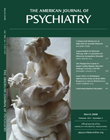To The Editor: In the September 2007 issue of the
Journal, David Mamo, M.D., M.Sc., et al.
(1) reported that at clinically effective doses (10–30 mg/day) aripiprazole exerts more than 80% striatal dopamine D
2 receptor occupancy in patients with schizophrenia. Correspondingly, higher striatal D
2 occupancy (>90%) was associated with the development of extrapyramidal side effects (dystonia, parkinsonism). Aripiprazole was distinguished by a low serotonin 5-HT
2 :D
2 affinity ratio (52% [SD=18%] versus 87% [SD=4%], respectively) and a low 5-HT
1A receptor occupancy (mean=16%)
(1) . The authors implied that aripiprazole’s partial D
2 agonist properties accounted for a low propensity for extrapyramidal side effects.
In several controlled trials, the rate of aripiprazole-induced extrapyramidal side effects was reported similar to placebo; however, it was the rate of aripiprazole-induced akathisia reported as being significantly higher (approximately 20%) in patients with schizophrenia and bipolar mania
(2,
3) . The estimated rate of aripiprazole-induced akathisia in naturalistic settings has been shown to be even higher
(4) . The pathophysiological mechanisms and treatment of akathisia differ from that of other extrapyramidal side effects. Anticholinergic agents that are efficacious in treating dystonia and parkinsonism are apparently ineffective in treating akathisia. In contrast, a robust anti-akathisia effect of mianserin and mirtazapine (both with marked 5-HT
2A antagonism), comparable with propranolol (the drug of choice for treating akathisia), has consistently been shown in patients treated with first-generation antipsychotic agents, underscoring the role of 5-HT
2A receptor antagonism in the pathophysiology and treatment of akathisia
(5) . Preliminary evidence indicating an anti-akathisia effect of the selective 5-HT
2A inverse agonist ACP-3
(6) supports this assumption. Notably, the 5-HT
1A agonist buspirone was ineffective as an anti-akathisia agent
(7) . We suggest that aripiprazole’s partial agonism at the D
2 and 5-HT
1A receptors accounts for the low incidence of extrapyramidal side effects but does not “protect” against akathisia. Noteworthy, five (42%) of 12 participants in the study developed restlessness
(1), which may well have been an expression of akathisia. A sufficient degree of the 5-HT
2A antagonism and a high 5-HT
2A :D
2 occupancy ratio are essential to prevent or ameliorate drug-induced akathisia. Elucidation of pathophysiological mechanisms and efficacious treatment of akathisia are imperative because of akathisia’s association with non-compliance and suicidal and violent behavior.

